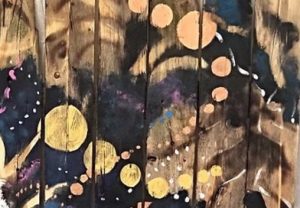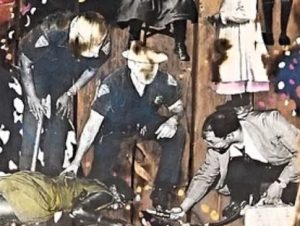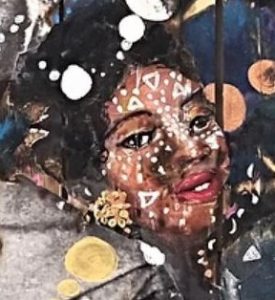“She dream in technicolor,
Live black and white”
Noname
Lavett Ballard asks “How Qualified do we Have to Be?”
Ballard’s work in this series draws heavily on decoupage and painting while also incorporating aspects of modern artistic techniques, such as the use of Photoshop in preparing her images for collage. The
HerStories Shrine Installation was catalyzed by Ballard’s extensive research at the Schomburg Center for Research in Black Culture in New York City, where her primary focus has remained
pre-1970s images of black lives and individuals. Her work extends past simply finding and pasting images together; decisions to slice neatly, tear haphazardly, over-saturate images, leave them in their original state, combine them, and oblige certain photos to stand alone, all serve to inform the final composition of each HerStories piece. “How Qualified Do We Have To Be?” is a monument to Ballard’s versatility in using her art to communicate meaning. The historical and artistic context behind this piece is rich and serves to invite crucial dialogue on the status of black lives in America, but the laborious and intensive nature of the piece’s assembly also offers its own message: how much of the world around us did black women create with similar assemblages of creativity, effort, and intention?
For this piece, Ballard has selected numerous images of black women and girls, many of which have their visages adorned with white paint in geometric patterns in similar style to the picture to the left. The paint adds a graphic sensibility to the work as a whole, helping to bridge the stylistic gap between older photographs and the colorful patterns swirling throughout the piece. However, the paint is also
highly reminiscent of tribal body adornment seen throughout many African cultures, marking a clear connection between the women in this piece and their heritage in the diaspora from the continent. Such connections serve, like the references to generations past in “Reality Check”, to indicate the longevity of black women’s struggle to define themselves upon their own terms. In deconstructing complete images of black women, then putting them together in new configurations, Ballard is participating in a kind of collective “re-IMAGE-ing” of black history a la Kimberly Douglas’s work in “Stuck”. Both artists are using their powers of assemblage in order to deconstruct, then rebuild, narratives around their own image and use of space.

“Qualified” is dominated implicitly by its background, a fence assembled out of reclaimed wooden planks. Ballard herself has stated that the use of fencing was intended to address the exclusion of black people from American society and freedoms, but also from their own history and the ability to connect with one another along shared cultural threads. The work of finding and assembling the fence pieces, smoothing them down and standing them up, is in marked contrast to the delicate, almost womanly-seeming work of hand painting swirls of circles and other colorful designs throughout the collage. The construction of the fence itself speaks directly to the kinds of labor historically delegated to enslaved or indentured black people, while the painting and design is wholly of Ballard’s own vision and mind. Such an interplay not only highlights Ballard’s commitment to constructing a narrative within the piece, but a narrative of the piece as well.
 In the age of the internet, with so many images and pieces of text available for download and use, the intentional and curated collage is more accessible than ever as a medium for artists looking to make a statement. “How Qualified Do We Have To Be?”, though, is as much a historical bibliography as it is a work of visual intrigue. With extensive research at the Shomburg Center informing her work, Ballard threw down a gauntlet; not only would her work reflect something of herself, but also something of history. A historian, painter, graphic designer, body artist, construction worker, and author of visual narratives, Lavett Ballard is the singular driving force behind the production of this piece, much in the same way that “Stuck” is so completely the work of one black woman. In “Qualified”, however, Ballard asks the question implicit in Douglas’s own work: How qualified do we have to be to be an artist, a model, a citizen, a voice?
In the age of the internet, with so many images and pieces of text available for download and use, the intentional and curated collage is more accessible than ever as a medium for artists looking to make a statement. “How Qualified Do We Have To Be?”, though, is as much a historical bibliography as it is a work of visual intrigue. With extensive research at the Shomburg Center informing her work, Ballard threw down a gauntlet; not only would her work reflect something of herself, but also something of history. A historian, painter, graphic designer, body artist, construction worker, and author of visual narratives, Lavett Ballard is the singular driving force behind the production of this piece, much in the same way that “Stuck” is so completely the work of one black woman. In “Qualified”, however, Ballard asks the question implicit in Douglas’s own work: How qualified do we have to be to be an artist, a model, a citizen, a voice?
They ain’t gonna wanna see my silhouette rap

 In the age of the internet, with so many images and pieces of text available for download and use, the intentional and curated collage is more accessible than ever as a medium for artists looking to make a statement. “How Qualified Do We Have To Be?”, though, is as much a historical bibliography as it is a work of visual intrigue. With extensive research at the Shomburg Center informing her work, Ballard threw down a gauntlet; not only would her work reflect something of herself, but also something of history. A historian, painter, graphic designer, body artist, construction worker, and author of visual narratives, Lavett Ballard is the singular driving force behind the production of this piece, much in the same way that “Stuck” is so completely the work of one black woman. In “Qualified”, however, Ballard asks the question implicit in Douglas’s own work: How qualified do we have to be to be an artist, a model, a citizen, a voice?
In the age of the internet, with so many images and pieces of text available for download and use, the intentional and curated collage is more accessible than ever as a medium for artists looking to make a statement. “How Qualified Do We Have To Be?”, though, is as much a historical bibliography as it is a work of visual intrigue. With extensive research at the Shomburg Center informing her work, Ballard threw down a gauntlet; not only would her work reflect something of herself, but also something of history. A historian, painter, graphic designer, body artist, construction worker, and author of visual narratives, Lavett Ballard is the singular driving force behind the production of this piece, much in the same way that “Stuck” is so completely the work of one black woman. In “Qualified”, however, Ballard asks the question implicit in Douglas’s own work: How qualified do we have to be to be an artist, a model, a citizen, a voice?